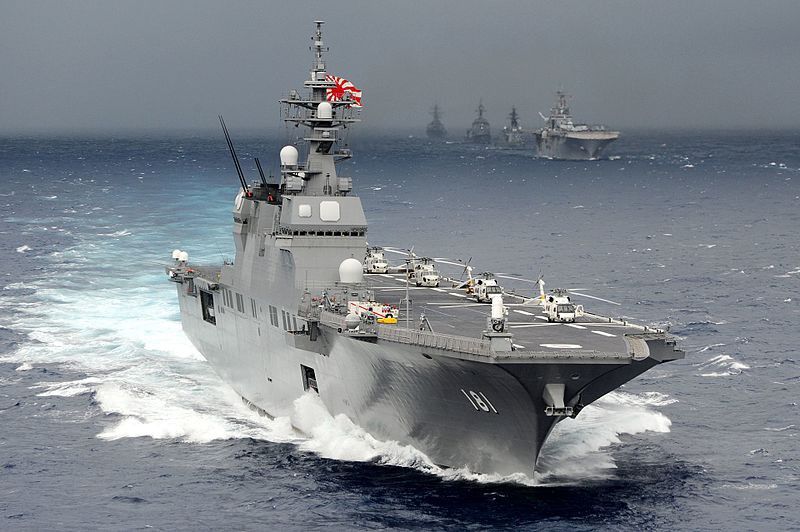This is the pre-publication draft of my column in Business Standard today.
This is an archived blog post from The Acorn on Medium.

When Japan’s Prime Minister Shinzo Abe visits India next week, he does so amid a nuclear crisis in North East Asia that is itself wrapped in a wider, deeper crisis around the shifting balance of power in East Asia and the Western Pacific Ocean. North Korea’s recent nuclear and missile signalling has added a tangential urgency to Japan’s growing insecurities arising from China’s sprint to unseat the United States as the hegemonic power in the region. The advent of Xi Jinping’s presidency confirmed suspicions that China’s “peaceful rise” was a comforting myth. And now, the advent of Donald Trump’s presidency has reinforced fears that arose under his predecessor’s administration that the United States’s reliability in a conflict against China can no longer be taken for granted.
The world as three generations of Japanese knew it has changed. Many are finding it hard to accept this.
Mr Abe has been among the few Japanese political leaders to appreciate the changing scenario in realist terms. He has used his political capital to reorient Japanese foreign and security policies — including making highly-contested changes to the country’s pacifist constitution. Yet I am not sure if the Japanese establishment and society can get over seventy years of living under the comfort of a US security cover appreciate that the good old days might have ended, never to return. While Mr Abe remains popular, there are powerful voices within his party and among parliamentary allies that strike discordant notes when it comes to defence and security. As typical scandals eat into his stock of political capital, Mr Abe is fighting for enough time to push through his security agenda.
Even as he steers the ship of the state tries onto a new, more independent course, the demand for Japanese power is being felt by every East Asian country that is outside Beijing’s orbit and wishes to remain so. Viet Nam, Australia, Indonesia and Singapore all have reasons to resist being dominated by China but calculate the risks of standing up to China are too great, especially if none of the others steps forward too. Post-Doklam, India has shown itself capable of dealing with Chinese coercion, but New Delhi might not show the same tenacity in the South China Sea as it demonstrated on its own frontiers. That leaves Japan as the only East Asian power that has both the interest and the wherewithal to galvanise a regional balance of power that provides some insulation against domination by China. Japanese leadership will put the spine in others.
It is often argued that enduring wartime memories will make East Asian countries suspicious of Japanese power. While perpetuating this argument serves Beijing’s interests, it is also true that Japanese post-war aid and investment has contributed to the economic development of the region. Any forward-looking government in the region will be more concerned with what China is doing and might do, than what the Japanese did before 1945. Few ASEAN countries are likely to protest a stronger Japan, many of them would welcome it.
So would India. Just take the maritime domain, for instance. It is in India’s interests for Japan to balance China in the Western Pacific, with the India lending a hand. This will allow the Indian Navy to concentrate on the Indian Ocean Region, with some help from the Japanese. This allows Japan to operate within the limits of its constitution and India within the limits of its capacity.
India’s naval expansion plan is a bright spot in an otherwise dismal defence acquisitions scene. However, it needs to be reviewed in the light of the massive addition to the PLA Navy in the past few years. After Mr Abe changed the rules, Japan now has the ability to offer surface ships, submarines, aircraft and information systems that can accelerate the Indian Navy’s expansion.
The first attempt at this — a proposal to procure ShinMaywa US-2 amphibious aircraft — failed to take off, but need not be seen as a failure if the two governments learn the right lessons from the episode. Despite Japanese companies successfully operating around the world, defence manufacturers are new and inexperienced in the export market. To make things worse, the Japanese bureaucracy is too conservative and is yet to internalise the changes brought under Mr Abe. Japan’s foray into defence exports has thus far been without success: attempts to sell maritime patrol aircraft to the UK and Indonesia, submarines to Australia and US-2s to India have fallen through.
Instead of looking at the ShinMaywa episode as the beginning of a strategic defence relationship — as Prime Minister Narendra Modi and Mr Abe had intended — the defence ministry concerned itself with getting a good price, local manufacturing and some technology that the Japanese could not sell. Individually, these demands make sense. Unfortunately, they miss the strategic big picture — that of making an advanced, friendly Japan a long-term defence partner.
When they meet, the two prime ministers must set up a joint task force to identify how to bring about strategic defence cooperation. There’s an immediate opportunity: the Indian Navy wants new submarines and Japan’s Soryu-class vessels are considered among the best. It can be a big deal, in many senses of the word.
For any of this to happen, Japan must see what Mr Abe does: that it can no longer avoid becoming and acting like a major power. As China and North Korea develop the capacity to inflict severe damage on the United States, Washington will be ever more reluctant to come to Tokyo’s aid. Ultimately, the biggest demand for Japanese power comes from Japan itself.
Three thoughts on Independence Day Next
The Agricultural Crisis is a Jobs Crisis
© Copyright 2003-2024. Nitin Pai. All Rights Reserved.